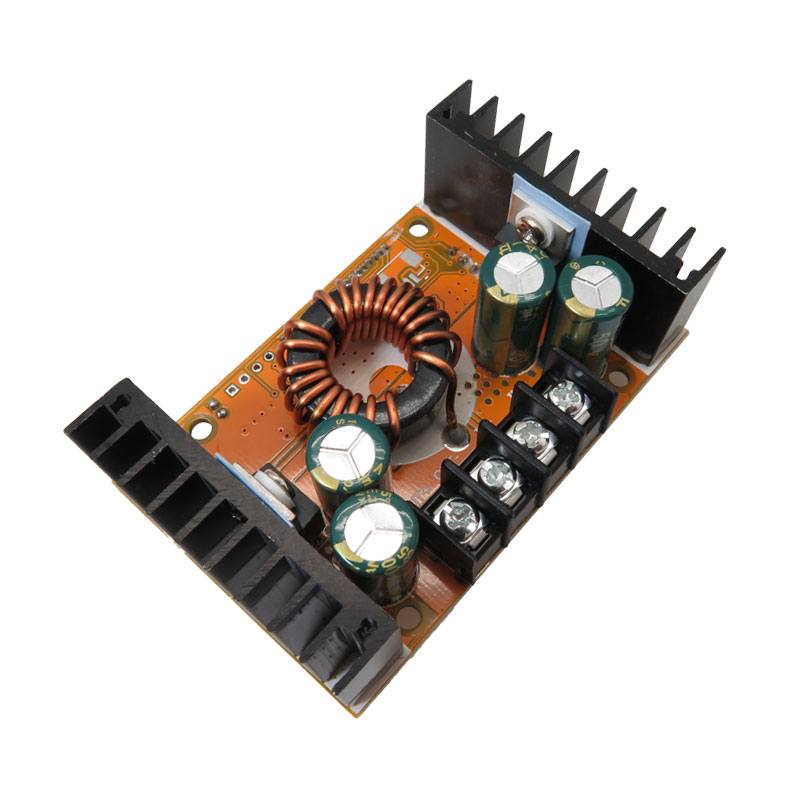635,590 تومان
در حال حاضر موجود نمی باشد
علاقه مندان : 13 نفر
وضعیت : فعال
تعداد مرجوعی : 0
دنبال کنندگان : 16 نفر
قدمت : 9 سال و 5 ماه و 1 روز
وزن : 129 گرم
کل فروش : 193 عدد
تعداد سفارش ها : 140 سفارش
4 از 5.0 با 7 رای
ماژول رگولاتور DC به DC کاهنده XL4016 تقویت شده دارای نمایشگر و قابلیت تنظیم ولتاژ و جریان خروجی
مبدل DC-DC یا به اصطلاح DC-DC converter مبدلی است که جریان DC یک منبع را از یک سطح ولتاژ به سطح ولتاژی دیگر تبدیل میکند و ولتاژ خروجی میتواند از ولتاژ ورودی بیشتر یا کمتر باشد. مبدل Buck نوعی مبدل DC-DC کاهنده است. از این مبدل برای کنترل سرعت موتورهای DC استفاده میشود. ماژول رگولاتور کاهنده مدل XL4016 در ابعاد 80x53x35 میلی متر و با کیفیت ساخت عالی و بدنه ی مقاوم و مستحکم ساخته شده است. این ماژول رگولاتور کاهنده دارای ولتاژ ورودی 7 تا 36 ولت و ولتاژ خروجی 1.5 تا 32 ولت می باشد و از جریان خروجی حداکثر 10 آمپر برخوردار است اما پیشنهاد می گردد برای عملکرد بهتر این ماژول جریان خروجی 8 آمپر گرفته شود.
برای عملکرد بهتر ماژول توصیه می گردد که فن روی آن نصب شود تا گرمای ایجاد شده باعث کاهش بازدهی و طول عمر ماژول نشود. ماژول رگولاتور کاهنده با فرکانس 300 کیلوهرتز دارای راندمان تبدیل تا 95 درصد می باشد.
تفاوت عمده این ماژول رگولاتور کاهنده ولتاژ، وجود صفحه نمایش برای میزان تغییرات ولتاژ و جریان با دقت 0.01 ولت و 0.01 آمپر بر روی صفحه نمایش سه رقمی است. لازم به ذکر است این ماژول دارای قابلیت کالیبره شدن می باشد تا خطای نمایش را به حداقل برساند.
کاربرد ماژول رگولاتور کاهنده ولتاژ DC به DC :
- تبدیل برق ولتاژ بالا
- خودرو
- برق صنعتی
- شارژ باتری
مشخصات ماژول رگولاتور DC به DC کاهنده XL4016 :
- ولتاژ ورودی : 7 تا 40 ولت
- ولتاژ خروجی : 1.5 تا 35 ولت
- جریان خروجی : 8 آمپر
- دمای کار : -20 تا + 75 درجه سانتیگراد
- فرکانس کار : 300 کیلوهرتز
- محافظ اتصال معکوس: دارد
- جریان برگشتی خروجی: خیر
- محافظ اتصال کوتاه: دارد
- راندمان تبدیل : تا 95 درصد
- ابعاد : 80x 53 x 35 میلیمتر
Description:
Converting a higher DC voltage to a lower one is a common requirement found in most electronic circuits. This might be something like converting the 12V from a battery down to 5V in order to power an electronic board. A portion of that 5V may be further converted down to 3.3V to drive a lower voltage portion of the circuit. It is a class of switched-mode power supply (SMPS) typically containing at least two semiconductors (a diode and a transistor, although modern buck converters frequently replace the diode with a second transistor used for synchronous rectification) and at least one energy storage element, a capacitor, inductor, or the two in combination.
DC-DC step-down converters basically take a higher input voltage and convert it to a lower output voltage by chopping it up by rapidly switching the output power transistor on and off so that the output essentially looks like a square wave and then using an LC filter to smooth it back into a DC voltage on the output of the filter. DC-DC converters are inherently electrically noisy devices. Its job is to basically take a nice calm flat DC voltage and violently chop it up into pieces and then smooth the pieces back out into a DC voltage again using an output filter. That output filter consists primarily of the inductor and capacitors in the output circuit and depends heavily on the board layout to optimize the quality of the filter.
Application:
High Voltage Power Conversion
Automotive
Industrial Power
Distributed Power
Battery Powered
Features:
Input Voltage: 7 ~ 36V
Output Voltage: 2 ~ 32V continuously adjustable (can only be used as a buck module, the input must be greater than the output 1V or more)
Output Current: adjustable, maximum 10A ( recommended to use within 8A, 5A or 70W below normal temperature can naturally dissipate heat, please strengthen the heat when it is exceeded! It is recommended to add a small fan! Supporting fan is available in the store! Constant current needs output voltage 2V or more Only adjustable , current regulation, only works in the constant current state. )
Output Power: up to 150W (recommended to use within 100W, please reduce power when using large differential pressure)
Accuracy: 0.01V, 0.01A, three-digit display, current unit is A
Conversion Efficiency: up to 95%
Short Circuit Protection: Yes, constant current value currently set by constant current
Input Reverse Connection Protection: Yes
Output Backflow: NO, (Please add a diode for charging)
Working Temperature: -20 ~ +75 degrees (pay attention to the power tube temperature when using, please strengthen the heat dissipation)
Installation Method: Up and down two acrylic plates, 8 nylon columns, 8 3mm wires, and it is easier to install the buttons in reverse.
Wiring Method: Terminal block or Soldering Terminal, (IN is input, OUT is output)
Module Size: 80 x 53 x 35mm
Voltage calibration:
In the case of power off, press and hold the “set” button, power on, enter the voltage calibration mode, the LCD screen starts to flash, release the set button, press the “set” button for plus, “OK” for minus, calibration For the correct input voltage, for example, the input voltage is 12.65V, then adjust the current voltage to 12.65V, automatically save after 2 seconds, the calibration is completed after the power is turned off!






